Modeling and perception of 'gesture reduction'
- PMID: 10992136
- PMCID: PMC1360169
- DOI: 10.1159/000028469
Modeling and perception of 'gesture reduction'
Abstract
The phenomenon of vowel reduction is investigated by modeling 'gesture reduction' with the use of the Distinctive Region Model (DRM). First, a definition is proposed for the term gesture, i.e. an acoustically efficient command aimed at deforming, in the time domain, the area function of the vocal tract. Second, tests are reported on the perception of vowel-to-vowel transitions obtained with reduced gestures. These tests show that a dual representation of formant transitions is required to explain the reduction phenomenon: the trajectory in the F(1)-F(2) plane and the time course of the formant changes. The results also suggest that time-domain integration of the trajectories constitutes an integral part of the auditory processing of transitions. Perceptual results are also discussed in terms of the acoustic traces of DRM gestures.
Copyright 2000 S. Karger AG, Basel
Figures

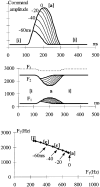

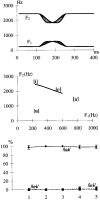

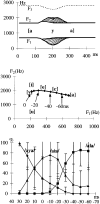
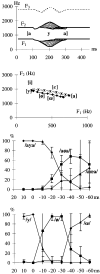
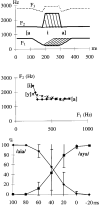
Similar articles
-
Perception of vowel-to-vowel transitions with different formant trajectories.Phonetica. 2001 Jul-Sep;58(3):163-78. doi: 10.1159/000056197. Phonetica. 2001. PMID: 11423784
-
Rapid reproduction of vowel-vowel sequences: evidence for a fast and direct acoustic-motoric linkage in speech.J Speech Hear Res. 1980 Sep;23(3):593-602. J Speech Hear Res. 1980. PMID: 7421161
-
Interspeaker variability in hard palate morphology and vowel production.J Speech Lang Hear Res. 2013 Dec;56(6):S1924-33. doi: 10.1044/1092-4388(2013/12-0211). J Speech Lang Hear Res. 2013. PMID: 24687447
-
Effects of hand gestures on auditory learning of second-language vowel length contrasts.J Speech Lang Hear Res. 2014 Dec;57(6):2090-101. doi: 10.1044/2014_JSLHR-S-14-0049. J Speech Lang Hear Res. 2014. PMID: 25088127
-
Coordination and coarticulation in speech production.Lang Speech. 1993 Apr-Sep;36 ( Pt 2-3):171-95. doi: 10.1177/002383099303600304. Lang Speech. 1993. PMID: 8277807 Review.
Cited by
-
Relation of vocal tract shape, formant transitions, and stop consonant identification.J Speech Lang Hear Res. 2010 Dec;53(6):1514-28. doi: 10.1044/1092-4388(2010/09-0127). Epub 2010 Jul 19. J Speech Lang Hear Res. 2010. PMID: 20643794 Free PMC article.
-
Perception of complete and incomplete formant transitions in vowels.J Acoust Soc Am. 2009 Sep;126(3):1427-39. doi: 10.1121/1.3167482. J Acoust Soc Am. 2009. PMID: 19739756 Free PMC article.
References
-
- d’Alessandro C, Castellengo M. The pitch of short duration vibrato tones. J. acoust. Soc. Am. 1994;95:1617–1630.
-
- Badin P, Fant G.198453–107.Notes on the vocal tract computations. Q. Prog. Status Rep., Speech Transm. Lab., R. Inst. Technol., Stockh., No. 2/3
-
- Beautemps D.1993. Récupération des gestes de la parole ὰ partir de trajectoires formantiques: identification de cibles vocaliques non atteintes et modèles pour les profils sagittaux des consonnes fricatives; thèse Institut National Polytechnique, Grenoble
-
- Browman C, Goldstein L. Ewan, Anderson, Phonol. Yb. Cambridge University Press; Cambridge: 1986. Towards an articulatory phonology; pp. 219–252.
-
- Brownlee SA. The role of sentence stress in vowel reduction and formant undershoot: a study of lab speech and informal spontaneous speech. University of Texas; Austin: 1996. PhD thesis.
Publication types
MeSH terms
Grants and funding
LinkOut - more resources
Full Text Sources
